- Progress in Context
- What’s Content material Advertising in SaaS?
- Why Most SaaS Startups Select Content material Advertising
- What Are the Options to Content material Advertising?
- Case Research of Dropbox: Skipped Content material (And Nonetheless Grew)
- So…is Content material Advertising a Should?
- When Ought to a SaaS Startup Use Content material Advertising?
- Placing It All Collectively By way of the Lens of HubSpot
- Fast Resolution Matrix
- Closing Ideas
In almost each business, there’s one apply that’s so broadly accepted that it feels just like the default. In SaaS, we will say it’s content material advertising.
Whereas its prevalence stems from its outcomes, it’s necessary to know if it’s the proper match for your enterprise with out leaping on the practice as a result of “everyone else is doing it.”
To reply the query that makes up the title, I spoke with consultants and went down the rabbit gap. The insights from my quest make up the majority of this text.
Let’s get proper to it!
Progress in Context
Simply so we’re on the identical web page, let’s make clear what progress means on this context.
For SaaS startups, particularly within the early to mid-stages, progress means a constant improve in certified signups, activations, and income. It’s not about self-importance metrics like pageviews or social media followers. Whereas these metrics can sign early model traction, they don’t essentially assure the actual traction that retains your enterprise afloat.
That mentioned, let’s begin from the bottom up.
What’s Content material Advertising in SaaS?
Software program-as-a-Service (SaaS) content material advertising is the apply of making useful, related, and constant content material that draws potential prospects, educates them about their ache factors, and positions your cloud-based answer as the best repair, with out being overly promotional.
Why Most SaaS Startups Select Content material Advertising
Earlier on, I famous that content material advertising is prevalent as a result of it delivers outcomes, that means it’ll hardly be adopted if it doesn’t transfer the needle.
Listed below are just a few the explanation why it’s principally used within the business:
Builds Model Consciousness
Content material places you in entrance of prospects after they’re actively looking for options. For instance, you might be seen when an individual inside your preferrred buyer profile (ICP) searches for details about an answer you provide. So, content material advertising is usually a technique to join your answer to them for the primary time.
Establishes Thought Management
High quality content material positions your organization as an skilled in your business. When executed proper, you turn out to be a trusted voice that prospects flip to for steering, providing you with an edge over opponents.
Extra Value-Efficient
This isn’t to say content material advertising is reasonable—it’s not. It’s solely comparatively extra reasonably priced than paid promoting channels. This makes it a better guess for startups that want predictable and sustainable progress methods.
Builds Belief
Content material serves as a belief lever for entrepreneurs. With 75% of shoppers saying they don’t belief promoting, content material is a technique to bridge that hole. Actually, creating content material that gives real worth and addresses prospects’ issues makes it simpler to construct belief.
These advantages—consciousness, cost-effectiveness, authority, and belief—clarify why content material advertising has turn out to be the go-to technique for a lot of SaaS firms.
What Are the Options to Content material Advertising?
Up to now few years, content material advertising has dominated most SaaS advertising discussions, but it surely’s removed from the one path to progress. Listed below are confirmed alternate options that could be higher fitted to your enterprise:
Progress Loops
In contrast to conventional advertising funnels, progress loops construct virality immediately into your product. Right here, every consumer serves as a suggestions loop for buying extra customers, making a self-sustaining progress cycle.
Slack is an ideal instance. When somebody indicators up, they’re naturally inspired to ask different teammates. Every new crew member then invitations others, thus creating compounding progress with out ongoing advertising spend.
Gong does this effectively. They’ve completely different skilled/social communities the place their customers get worth from peer connections.
Pay-Per-Click on Promoting
Because the title implies, PPC requires paying a certain quantity to advertise your model or product to a broader viewers. Google Adverts, Fb Adverts, and LinkedIn Adverts are generally used channels in B2B.
Aspect Notice: For startups in search of long-term progress, PPC alone is hardly sufficient. This technique calls for steady funding to maintain efficiency. Until you’ve a vault of funds to maintain ongoing advert spend, then you possibly can go for it.
Influencer Advertising
Though it’s comparatively unusual in B2B in comparison with B2C, influencer advertising is usually a highly effective addition to your advertising arsenal.
This method entails partnering with business consultants and thought leaders who’ve constructed belief and credibility to advertise merchandise to their established viewers.
Notably, the important thing distinction between B2B and B2C influencer advertising is subtlety. As an alternative of apparent endorsements, these partnerships usually present up as natural mentions, case research, or thought management content material that naturally mentions the model.
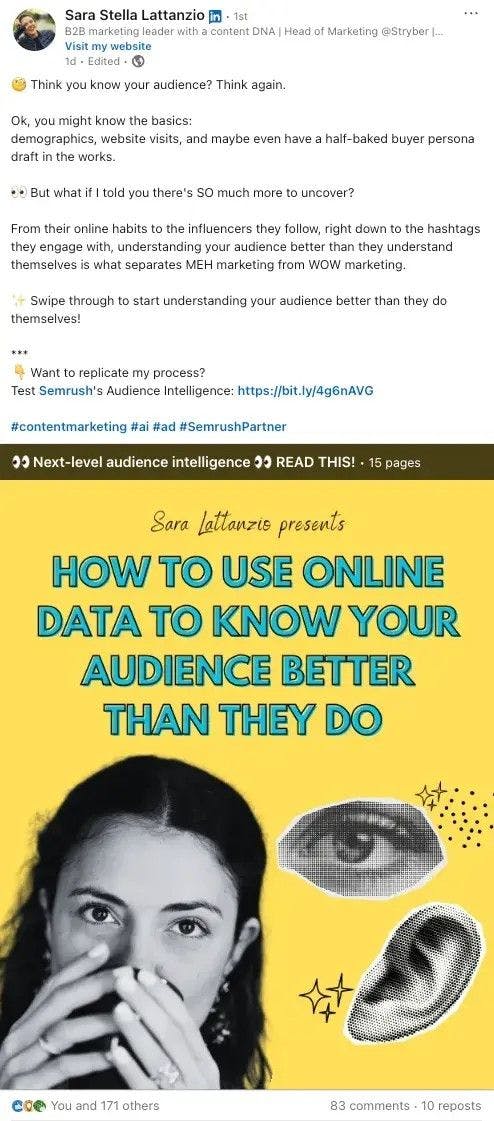
A very good instance of my level is Sara Stella Lattanzio’s LinkedIn submit about SEMrush. Whereas from the skin it could look like an informal skilled perception submit, for these accustomed to influencer advertising dynamics, it’s what it’s—strategic model promotion.
Affiliate Advertising
This type of advertising primarily depends on word-of-mouth. It entails leveraging networks of individuals to promote your software program to your audience for a fee.
Case Research of Dropbox: Skipped Content material (And Nonetheless Grew)
Whereas some firms leaned in direction of content material advertising as their core progress engine, others didn’t. Regardless of almost everybody in SaaS leaning towards content material, they defied the percentages and nonetheless managed to develop.
In 2007, Dropbox was based.
Dropbox entered the scene as a cloud-storage platform at a time when individuals couldn’t grasp the thought of saving recordsdata ‘in the air’—exterior of FTP or native file servers they knew.
You possibly can think about what the advertising brainstorming session should’ve regarded like inside Dropbox’s crew again then. How do you promote one thing individuals have by no means skilled?
However we all know how the story goes: quite than educating the market by way of in depth content material, they leaned into referral and product-led progress. This method as soon as drove 3900% consumer progress in 15 months.
At the moment, they’ve turn out to be the poster little one for that technique.
Nonetheless, Dropbox launched a weblog on December 18, 2007, but they by no means made content material their main progress engine.
A evaluate of their early content material reveals posts centered primarily on product updates quite than conventional content material advertising. To this point, their referral program stays their core technique and continues to drive progress.
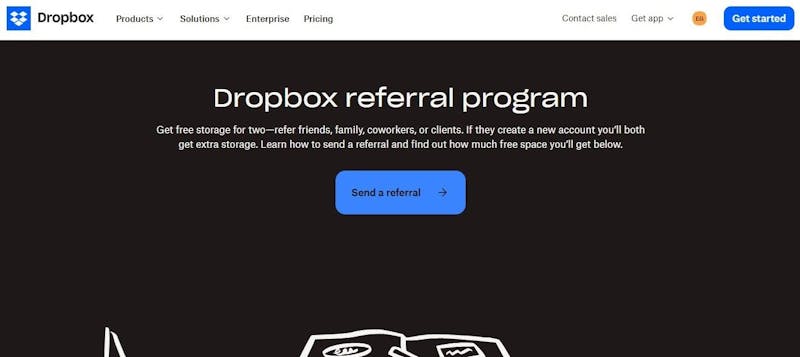
Their referral program remains to be very energetic. up to now.
Nonetheless, whereas this may increasingly appear promising, Dropbox is a singular case. Their product-market match, simplicity, and B2B/B2C hybrid mannequin offered them with levers that many startups lack. So, whereas they grew with out a lot content material, that playbook gained’t work for each SaaS product.
So…is Content material Advertising a Should?
Properly, the brief reply is not any. The lengthy reply is trickier, as with most issues in advertising: it relies upon.
So, what does it rely upon, precisely?
Let’s discover out.
When Ought to a SaaS Startup Use Content material Advertising?
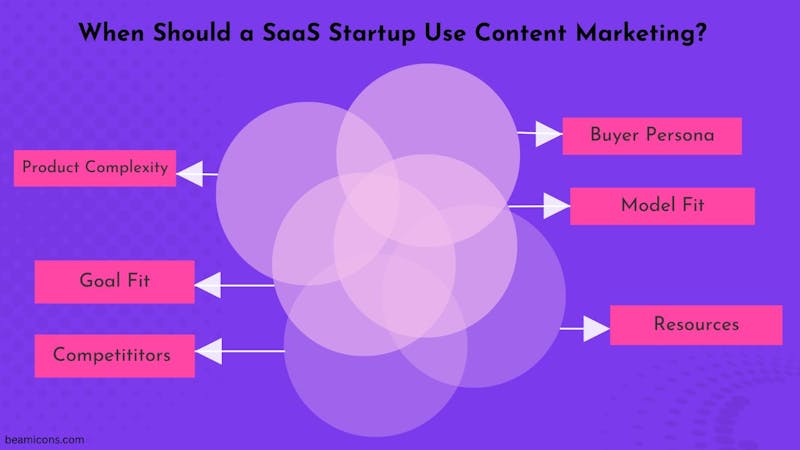
Earlier than you begin mapping out your advertising technique or executing something, try to be positive it aligns with just a few issues, that are:
- Your purchaser persona
- Your mannequin
- Your targets
- Your assets
- Your product
- Your opponents
Let’s have a look at how every of them issues in your advertising choices, we could?
Who’re your patrons?
So simple as my little query sounds, most companies nonetheless miss the mark. When you’re taking the time to resolve an issue, it is best to at the least promote it the place your preferrred prospects are most receptive.
The science behind that is understanding how potential patrons uncover and make buying choices. Understanding it will assist you nail your advertising methods, and influencing them turns into simpler.
The way you do that is by asking questions like:
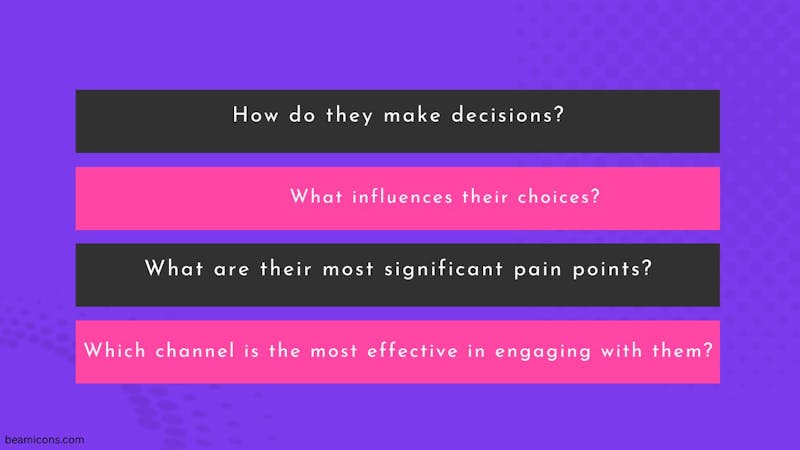
You possibly can conduct surveys and interviews along with your present prospects to realize a deeper understanding of what works finest for them. Use analytics instruments to observe their habits. You by no means know the way a lot this analysis will reveal in comparison with wild guesses and instinct.
All of it comes all the way down to understanding your viewers, which provides you readability earlier than investing in content material advertising.
I like how Jasmine Charbonier, a content material advertising strategist, places it: “Understanding your buyers isn’t just about creating personas—it’s about survival.” The load of her assertion hits arduous when she cites examples of how firms burn {dollars} in advertising spend as a result of they spend money on a type of advertising with out setting the muse, understanding their viewers’s wants.
It’s so simple as it sounds. Know your viewers, and also you’re ten instances nearer to creating an knowledgeable determination.
How do you earn a living?
The mannequin your enterprise makes use of to make income is essential. Your advertising choices range for every mannequin.
That’s as a result of every mannequin targets several types of patrons and follows a distinct gross sales cycle.
- Are you a freemium SaaS product?
- Is your product subscription-based?
- Are you extra of an enterprise “book a demo” kind?
Answering this enterprise mannequin query will assist you decide which advertising technique is the perfect match.
Take Zapier for instance; you should use their product with out having to fill out the dreaded bank card kind.
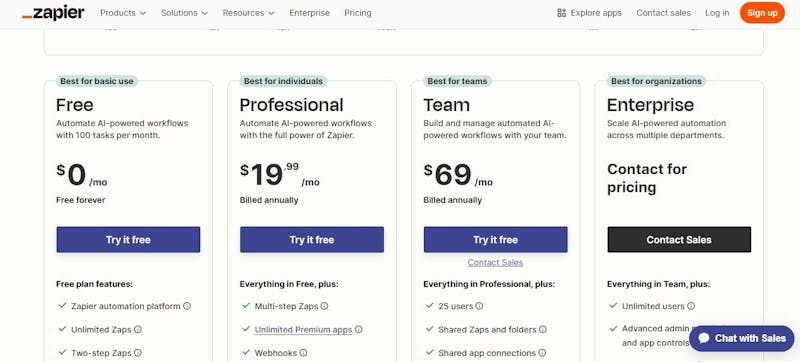
Most firms based mostly on freemium or free trial fashions would possibly have to forged a wider web (inside their ICPs, in fact) to advertise free entry and hook customers. Hypothetically talking, they work on the belief that customers will improve to unlock premium performance.
For these companies, paid promoting, influencer advertising, and affiliate packages is perhaps the way in which to go. Technically, customers have restricted monetary dedication, so it is smart. Since they’re extra centered on scale, their advertising purpose is to draw as many certified customers as attainable.
However, firms with greater ACVs usually want much less content material. Closing offers turns into extra about constructing relationships than casting broad nets.
For enterprise SaaS, the main target shifts to constructing private relationships—assume “book a demo” pages, gross sales calls, account-based advertising, or content material advertising. Earlier than prospects can decide to a significant monetary funding, they should belief the corporate and its answer.
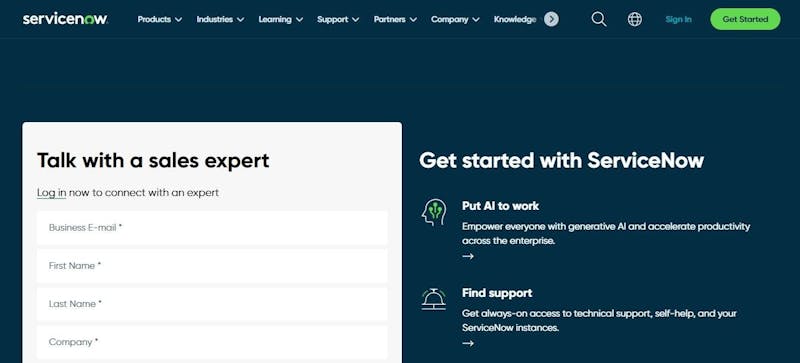
ServiceNow is an instance.
Since we’re specializing in startups, these with an enterprise mannequin would possibly discover it more practical to start with direct outreaches, strategic relationship constructing, and gross sales efforts if the purpose is to transform quick gross sales.
Put merely, it varies throughout SaaS fashions. Whereas an organization like Zapier would possibly profit from aggressive promoting to drive elevated consciousness, that broad-reach method will not be preferrred for an enterprise-focused platform like ServiceNow.
What assets do you’ve?
I ask once more, what assets do you’ve?
Whatever the technique you go for, the reality is that advertising isn’t low cost. Your assets, right here, might be in three classes: capital, capability, and time. Capital is your advertising funds. Capability is your crew’s experience and bandwidth. Time represents your runway.
Let’s have a look at every.
Capital
Most of the time, SaaS startups function with restricted funds. On this case, prioritising lower-cost channels like content material advertising, search engine optimisation, or progress loops turns into important. Nonetheless, “lower cost” doesn’t imply “no cost”—these methods nonetheless require substantial funding.
VC-backed SaaS startups usually worth speedy progress over gradual advertising methods. Right here, it is smart to spend money on paid acquisition, aggressive hiring, and even working a number of advertising experiments concurrently.
Capability
I gained’t dwell too lengthy right here—your funds largely determines your crew’s capabilities. However at each progress stage, it’s important to ask:
“Do we have the right people for where we’re headed?”
If the reply is not any, you’ve three choices: upskill present crew members, outsource specialised features, or rent new expertise.
Time
In enterprise, time equals runway.
Your obtainable timeframe can affect which advertising methods you possibly can realistically pursue:
- You probably have an extended runway, you possibly can spend money on slower-growth methods like search engine optimisation and electronic mail nurturing, amongst others.
- A shorter runway usually means the stress is excessive. In that case, faster-impact channels like paid promoting, outbound gross sales, influencer partnerships, or different techniques that generate quick traction are good choices.
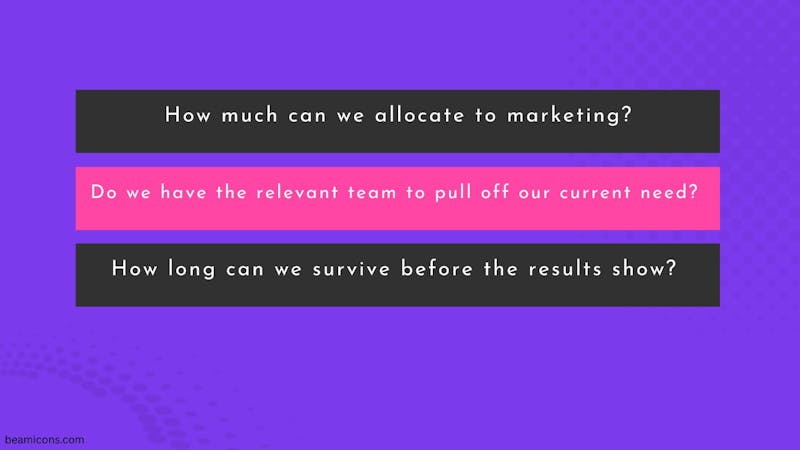
Answering these questions is a superb step in the proper route.
What are your targets?
Having outlined progress in context at first of this text, I have to observe that the time period is commonly relative. For instance, some founders could prioritise constructing consciousness or thought management versus changing quick gross sales.
In such circumstances—and contemplating all the opposite elements mentioned on this article—content material advertising is a great selection.
Conversely, in case your main goal aligns with our preliminary definition, content material advertising will not be a should.
In the end, your present enterprise targets ought to information your advertising choices simply as a lot as every other issue.
Product Nature
Figuring out whether or not content material advertising must be your start line additionally is dependent upon your product’s complexity.
For easy merchandise, friction is comparatively low. Consider instruments with seamless onboarding, intuitive consumer experiences (UX), and minimal setup. These are usually self-serve and require little to no consumer training.
Merchandise like Slack, Dropbox, and Calendly illustrate this effectively. For SaaS merchandise constructed like them, content material is perhaps a second thought in your progress story.
On the flip aspect, if in case you have a extra advanced or technical product with a steep studying curve, treating content material as an afterthought can damage your progress.
On this state of affairs, content material advertising is your pal. Every thing from academic content material, like in-depth guides, webinars, and product tutorials.
Rivals
It’d do effectively to make clear first that this isn’t about copying your opponents and calling it a day—no.
You’re merely gathering info to assist your individual advertising choices. In accordance with Oluwasegun Oyebode, CMO at Beagital, you’re discovering solutions to those questions:
- Which channels do they use essentially the most, and which of them aren’t fully energetic on? This info may assist you determine the place your organization needs to be to get a share of the market.
- Which channel appears to be providing them essentially the most ROI?
To drive residence this level, let’s have a look at Ahrefs and SEMrush.
Each firms provide search engine optimisation instruments for digital entrepreneurs and companies. They’re direct opponents with related merchandise and goal audiences.
Granted, these two manufacturers are business giants of their respective options, however I’m onto one thing right here.
We see that each manufacturers leverage content material advertising extensively—sustaining strong blogs, YouTube channels, and academic academies to nurture and convert customers.
They provide free instruments as lead magnets and host branded occasions: Ahrefs’ Evolve and SEMrush’s Highlight. Their social media presence is one other battleground the place each manufacturers are closely energetic.
Regardless of these similarities, their paths break up in some key areas.
For example, SEMrush runs an associates program (as of the time of penning this—Might 2025), whereas Ahrefs discontinued theirs roughly two years in the past. Right here’s an article by Tim Soulo, the CMO at Ahrefs, explaining why.
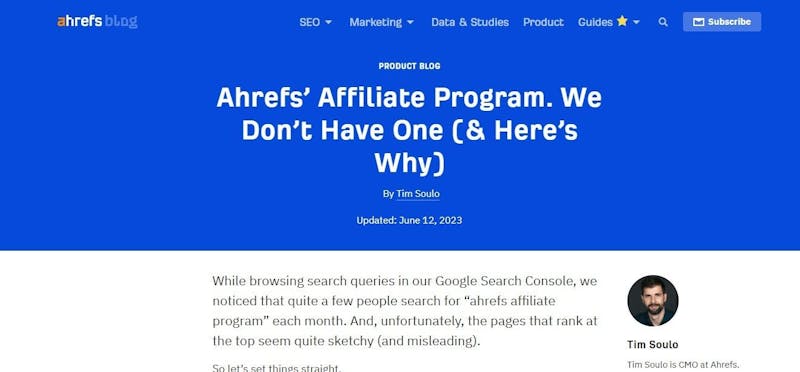
To save lots of you the difficulty, one of many issues he talked about was that 90% of their affiliate leads got here from simply 3% of associates. This prompted them to discontinue this system and work immediately with top-performing companions.
In the meantime, SEMrush’s associates program has confirmed profitable—with a 400% improve in new partnership signups in 2025 alone.
Whereas it’s nonetheless arduous to pinpoint the precise efficiency information of their total buyer acquisition, the truth that SEMrush has stored this system working since 2009 and continues to advertise and spend money on the channel alerts that it drives substantial outcomes. Companies don’t preserve doubling down on a channel for over 15 years simply because it’s good—it clearly works for them.
The broader level is that when opponents constantly execute particular advertising techniques efficiently, it usually alerts market validation for these approaches. As Oyebode places it, “It puts you in the position to compete properly without getting left behind.”
Nonetheless, as our case examine exhibits, wholesale copycatting gained’t lower it. The purpose is strategic adaptation—understanding what works for you and aligning with different elements mentioned on this article. This turns into particularly vital for startups with disruptive options, the place sticking too carefully to established playbooks can restrict your differentiation.
Placing It All Collectively By way of the Lens of HubSpot
Tying every little thing collectively might sound overly simplistic, however stroll with me right here.
One SaaS model exemplifies content material advertising executed proper—HubSpot.
Since their founders, Brian Halligan and Dharmesh Shah, wrote a e-book titled “Inbound Marketing”, HubSpot has dominated the content material advertising world. Their progress engine is primarily constructed on a content-first technique.
However how did they arrive to realize this? They’re an ideal instance of aligning with this six-factor framework.
HubSpot’s core viewers is SMBs trying to scale their CRM, gross sales, and advertising efforts. Ideally, these patrons don’t depend on RFPs or gross sales reps. As an alternative, they actively self-educate to resolve their enterprise issues.
By way of enterprise mannequin match, HubSpot thrives on retention. Their survival doesn’t hinge on one-off purchases, however on long-term buyer relationships. Content material is without doubt one of the some ways to go about that.
Firstly, HubSpot didn’t chase instantaneous revenue. As an alternative, they staked their declare on first changing into a trusted business authority. And, contemplating they have been championing a brand new technique to market, they needed to concentrate on doing simply that.
How do I do know all this? Properly, under is a 2012 article from HubSpot that completely captures their mindset and mission on the time. And sure, I perceive that manufacturers usually inform tales to stretch past the “we want your money” narrative.
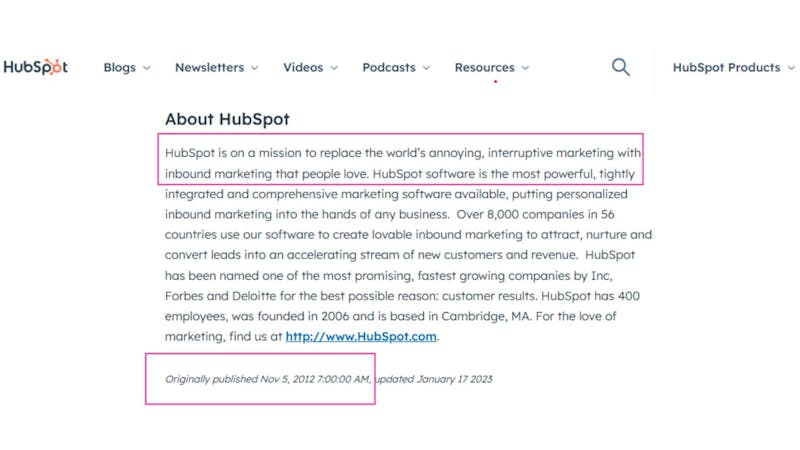
Nonetheless, there’s solely a lot a model can faux. HubSpot has constantly stayed dedicated to reaching its mission. This, too, explains why they’ve caught to content material (inbound advertising)—and right now, it’s working for them.
On assets, I’m tempted to say HubSpot had all of it. In contrast to most startups, they loved enterprise capital backing. So, to be honest, you may not wish to place your self on par with them, however this doesn’t imply you want outrageous funding to make content material advertising work. Your good is sweet sufficient.
The distinction is the main target. Whereas HubSpot may spend money on complete academies and business reviews, resource-constrained startups want to select one academic format and execute it exceptionally effectively.
Though their device is much less advanced, they nonetheless wanted content material to scale back or take away any type of friction customers could face.
Lastly, I like that they captured my earlier level: if you happen to’re bringing one thing disruptive, counting on a competitor’s playbook solely limits you. Whereas HubSpot launched years after their direct competitor—Salesforce—they didn’t mimic Salesforce’s methods. They caught with what they believed would work for them, and it did. That was content material advertising.
How is it Working for Them?
By way of income, HubSpot is doing impressively effectively. Their complete income in 2024 was valued at $2.63 billion. Their income report for Q1 2025 was over $700 million, which is 14% greater than Q1’24.
Past monetary metrics, their model mentions, thought management place and neighborhood engagement present how effectively content material advertising can yield outcomes. You possibly can’t scroll by way of advertising Twitter or LinkedIn with out seeing HubSpot content material, citations, or discussions.
On the finish of the day, HubSpot isn’t only a case examine of profitable content material advertising. They’re a case examine in strategic alignment between content material, product, purchaser behaviour, and every little thing in between.
Fast Resolution Matrix
You should use this scoring system to guage if content material advertising is true in your startup:
IssueExcessive Content material Advertising Match (3 factors)Medium Match (2 factors)Low Match (1 level)Your RatingPurchaser PersonaSelf-educating, research-heavy buyersMixed shopping for behaviorRelationship-driven, sales-led buyers___/3Enterprise MannequinFreemium, low-touch SaaSMid-market subscriptionEnterprise, high-touch___/3Major TargetsModel consciousness, thought leadershipBalanced progress approachImmediate income focus___/3SourcesLengthy runway, restricted budgetModerate resourcesShort runway, excessive budget___/3Product ComplexityAdvanced, wants educationModerate complexitySimple, intuitive___/3Aggressive PanoramaContent material-heavy competitionMixed strategiesRelationship-focused competition___/3
Scoring information
· 15-18 factors: Content material advertising is important in your progress
· 10-14 factors: Content material advertising must be a part of your combine, however not essentially main
· 6-9 factors: Think about alternate options first, content material as a secondary technique
Alternatively, be at liberty to make use of the picture model for reference.
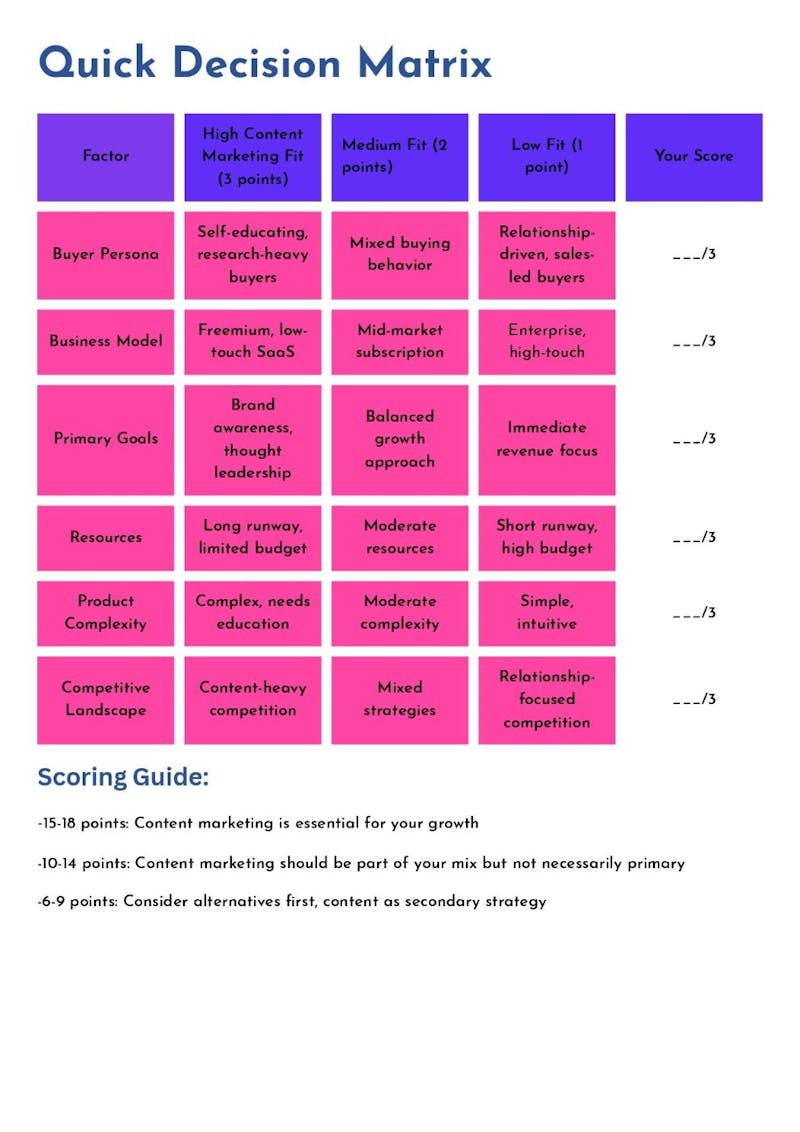
Closing Ideas
All issues thought of, we will agree that advertising is hardly a one-size-fits-all recreation.
As a lot as I’d like to say that certainly one of these elements must be your high precedence, I can’t. The majority of the work is discovering the candy spot the place all of those align, then doubling down and develop. It’s your name.
It’s additionally value noting that if you happen to discover your candy spot in content material advertising, you have to be prepared to be devoted. As Ryan Regulation and Jimmy Daly at Animalz put it, “Content isn’t a marketing tactic you can easily turn on and off.” Half-hearted content material advertising is commonly worse than no content material advertising in any respect.
Godspeed!
This text was initially printed by Oluwagbemiga Makinde on HackerNoon.









